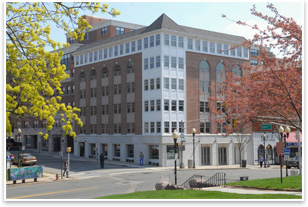|
Florida, Indiana Recognize Green Building Initiative’s Green Globes Rating System
by Russell Boniface
Associate Editor
Summary: Florida
and Indiana recently joined the growing list of states that recognize
the Green Building Initiative’s (GBI) Green Globes environmental
assessment and rating system. The not-for-profit, Portland, Ore.-based
Green Building Initiative, through its Green Globes system, promotes
the adoption of energy-efficient building practices. Florida and
Indiana combine to make a total of 19 states recognizing GBI’s
rating system.
 In May, Florida Governor Charlie Crist signed into law an energy
and economic development package reducing greenhouse gas emissions,
requiring new and renovated buildings meet GBI’s Green Globes
environmental assessment and rating system. This law also requires
buildings to meet the Florida Green Building Coalition’s green
building program and the U.S. Green Building Council’s LEED® or
equivalent national rating system. In May, Florida Governor Charlie Crist signed into law an energy
and economic development package reducing greenhouse gas emissions,
requiring new and renovated buildings meet GBI’s Green Globes
environmental assessment and rating system. This law also requires
buildings to meet the Florida Green Building Coalition’s green
building program and the U.S. Green Building Council’s LEED® or
equivalent national rating system.
In July, Indiana Governor Mitch Daniels issued an executive order establishing that new state buildings meet the Green Globes system or LEED criteria. This is the first executive order to recognize Green Globes.
Different states, different goals
Mark Rossolo, director of state and local outreach for GBI, says that each bill is significantly different but inclusive, and that there is a difference. “Florida is more encompassing, a larger, more comprehensive bill. Indiana Governor Mitch Daniels wanted to establish a green policy of his own. It is significant because it is the first official executive order to recognize Green Globes. We have been recognized in legislation by state policy makers before, but Indiana was the first executive order. We are excited.”
 Rossolo explains that the executive order focuses on state public
buildings being built as energy-efficient using the Green Globes
system, while the Florida legislation focuses on carbon reduction
and using Green Globes with LEED. “That is the major difference,” he notes. Rossolo explains that the executive order focuses on state public
buildings being built as energy-efficient using the Green Globes
system, while the Florida legislation focuses on carbon reduction
and using Green Globes with LEED. “That is the major difference,” he notes.
“The trend is that green building and energy-efficiency policies have been hot topics for state governments around the country,” Rossolo continues. “We have seen well over 200 bills for 2009 dealing with green building. Many bills are being looked at. Both Florida and Indiana formally recognize Green Globes. The trend is toward inclusion, leaving the market open, and allowing people to pick what works best for them. When you have multiple tools in the marketplace, people gravitate toward one or the other, that is, some people might like LEED better than Green Globes, and some might like Green Globes better than LEED. The important thing is that we are giving them tools and access to use either. Ultimately, both USGBC and the GBI are going after the same things—change the built environment. We both want the buildings to be green. That’s the ultimate goal.”
 Rossolo enthuses: “Ideally, we will get to the point where a rating system is not necessary. People fundamentally are doing more sustainable things. We’re not there yet, but that’s what we’re trying to get to. That is what our organization wants.” Rossolo enthuses: “Ideally, we will get to the point where a rating system is not necessary. People fundamentally are doing more sustainable things. We’re not there yet, but that’s what we’re trying to get to. That is what our organization wants.”
Florida and Indiana join Arkansas, Connecticut, Hawaii, Illinois, Kentucky, Maryland, Minnesota, New Jersey, North Carolina, Oklahoma, Pennsylvania, South Carolina, South Dakota, Tennessee, Virginia, and Wisconsin as states that have formally recognized Green Globes in legislation.
|


 In May, Florida Governor Charlie Crist signed into law an energy
and economic development package reducing greenhouse gas emissions,
requiring new and renovated buildings meet GBI’s Green Globes
environmental assessment and rating system. This law also requires
buildings to meet the Florida Green Building Coalition’s green
building program and the U.S. Green Building Council’s LEED® or
equivalent national rating system.
In May, Florida Governor Charlie Crist signed into law an energy
and economic development package reducing greenhouse gas emissions,
requiring new and renovated buildings meet GBI’s Green Globes
environmental assessment and rating system. This law also requires
buildings to meet the Florida Green Building Coalition’s green
building program and the U.S. Green Building Council’s LEED® or
equivalent national rating system. Rossolo explains that the executive order focuses on state public
buildings being built as energy-efficient using the Green Globes
system, while the Florida legislation focuses on carbon reduction
and using Green Globes with LEED. “That is the major difference,” he notes.
Rossolo explains that the executive order focuses on state public
buildings being built as energy-efficient using the Green Globes
system, while the Florida legislation focuses on carbon reduction
and using Green Globes with LEED. “That is the major difference,” he notes. Rossolo enthuses: “Ideally, we will get to the point where a rating system is not necessary. People fundamentally are doing more sustainable things. We’re not there yet, but that’s what we’re trying to get to. That is what our organization wants.”
Rossolo enthuses: “Ideally, we will get to the point where a rating system is not necessary. People fundamentally are doing more sustainable things. We’re not there yet, but that’s what we’re trying to get to. That is what our organization wants.”